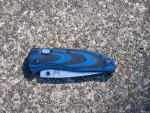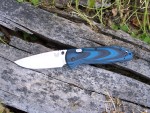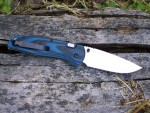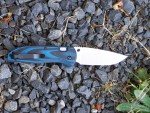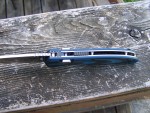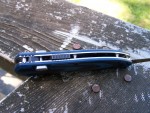Having toured the Benchmade Knives factory several times over the years, one thing that has always struck me about it is how clean it is. I mean their plant is super clean. How they manage to keep the place “that” clean while operating several shifts is beyond me. Additionally, it is pretty darn quiet in the Benchmade plant. I was amazed some years ago when I watched the laser cut knife blanks in almost total silence; it was amazing to watch the laser slice through the sheets of steel. The one problem Benchmade has is that they have a difficult time finding top-notch employees to operate some of their hi-tech CNC machines and other equipment. Don’t expect to walk in the front door, fill out a job application, and get hired just because you graduated high school. It ain’t gonna happen1. There’s a lot more involved in the making of knives, from beginning to end; there’s a lot more than you think involved.
All knife designs start out as a drawing, or an idea in someone’s head. In the case of Benchmade these drawings are done with the aid of computer-assisted programs. I’ve designed more than a few knives in my life, some of which are in production; a new fixed blade design is forthcoming early next year by a major knife company. My drawings are crude, but I’ve managed to convey the concept of the design, some how, in my drawings. My only claim to fame is that I took two years of mechanical drafting in high school, and I was just “okay” at it. However, with the aid of others who are more knowledgeable on these things, my designs have come to life. One of their knowledgeable persons is custom knife maker Brian Wagner. He knows what I want, and he brings my ideas and drawings to life. Thanks, Brian!
Of course, after a knife is designed, a prototype or two, or more, is next in the process. No matter how good a knife might look on paper, when it is brought to life, sometimes that knife isn’t want you wanted or expected. So, it’s back to the drawing board for refinements or at times a complete re-do on the design. At times, the knife design is just trashed; there’s just too much involved in refining it to make it what it should be. Testing of prototypes is also involved, and over the years, Benchmade has sent me more than a few of their prototypes for testing, and ultimately resulting in a finished product. At times, I had to return the one and only prototype. Ouch, that hurt! Other times, there were several prototypes made and I was allowed to keep my sample after I was finished testing and evaluating it. To be sure, other big name knife companies have asked for my input and sent me prototypes to test.
Knife companies then have to start deciding on the right materials for the new knife design, which is not an easy task at times. We wonder why so many different steels are used in different knives? Yeah, it’s one of those “things” that sometimes remains a mystery. Many times, the price point of the finished product calls for a particular steel in the blade. Other times, the intended use of the knife results in a certain type of steel. The same goes for the liners, handle materials, belt clips, and the entire ball of wax. So, it’s not an easy project to take a knife from the point of being just an idea in someone’s head to being a finished product. In several of my knife designs, it took a year or sometimes several years to see the idea through to the finished product. Benchmade designs many of their knives in-house, and many others are the result of a collaboration with custom knife makers.
I’ve seen some of Benchmade’s in-house designers sitting at their desks or drawing boards just starring, and I could only imagine what was going through their minds– what to change, what not to change, which steel, which screws, et cetera. It’s not as easy as one might imagine it would be to design a knife and produce the finished product. Also, lastly, let’s not forget about actually marketing a new knife design, which is not was easy as you might think either.
Going back many years ago, Benchmade’s owner, Les d’Asis, actually went through a bankruptcy when he was first starting out. However, as is often the case, those who have gone through the fire come out much stronger for it and learn by their mistakes and are all that much better for it. Benchmade is a leader in the cutlery industry, and their knives are always in great demand, so much so that they are often back-ordered on many designs. Try as they might, it’s hard to keep up with supply and demand.
Today, we’ll take a look at the Benchmade Model 665 APB folder, and it was one of those knives that seemed to take forever to come out due to design changes, many of them, which were involved before the knife was released. I know that Derrick Lau, who handles getting samples out to us worthless writers, was sick and tired of hearing from me via e-mail begging and probably even “demanding” my sample for an article. However, Derrick took it all in stride and is great to work with in this respect. Benchmade has a winner with Lau in this respect.
To begin with, the 665 APB (APB stands for Ambidextrous Push Button) is not an automatic folder; it is an assisted-opening folder on which you can push the APB button on either side of the handle to unlock the blade, once it is opened. By the way, Benchmade also has an APB automatic opening folder, for those living in enlightened states that allow the carry of an automatic opening folder. The 665 APB has a blade that is 3.60-inches long; this is a very popular blade length at Benchmade when it comes to folders because it’s not too long and not too short. Blade thickness is 0.124 is made out of 154CM stainless steel, which at one time was the domain of custom knife makers, and I’m happy to see it being used in some production knives. Rockwell comes in at 58-61. It’s a bit hard, but it holds an edge a good long time and doesn’t chip either. The blade is a drop point style– a very popular and useful design. The pocket clip is designed for tip-up carry, and the clip is reversible for right or left pocket carry. The 665 weighs in at 5.4 oz, and you hardly know it’s in your pocket. The handle material is G10 with a blue/black design and light texturing. Of course, we have an ambi thumb stud, for sure, and easy opening. Just push that thumb stud out a bit, about 20-25 degrees, and the assisted-opening device takes over and opens the blade the rest of the way. The blade has a soft satin finish on it. And, to be sure, the thumb stud is black, which really offsets the look of the blade; I like it. There is also a manual locking device on the top of the handle to lock the knife closed or more securely in the open position, which is excellent!
The Model 665 APB is from the Benchmade Blue Class of knives, designed for emergency/fire personnel, as well as law enforcement and military use. You see, it comes back to the design and the intended purpose of the knife, as mentioned above, as to which materials are used and why! The 665 is made for hard-use, to be sure. Again, the selection of materials dictates how well the knife will hold. Also, let’s not forget, the limited lifetime warranty from Benchmade. Plus, they will re-sharpen any of their knives, if you send them back with a small fee to cover return postage and handling. Not many knife companies offer this service.
I did like the “friction” grooves on the top rear of the blade, and the top front of the handle of the 665; these are placed just perfectly for use in the fencing-style of grip on the knife. Many knife users actually use this grip style without even realizing it. It’s very popular for many types of cutting chores, as well as self-defense use. However, keep in mind that a knife, any knife, is designed as a tool first and foremost and as a weapon secondly!
I tested the 665 over a period of several weeks, carrying it daily in my right front pocket. I hardly knew it was there until I needed it. The blade opened fast with the assisted-opening device. It opened much faster than some other assisted-opening folders from other makers, and the blade locked-open rock solid and was easy to close, using either both or one of the sliding APB buttons on the handle. Nice! Of course, the knife came hair-popping sharp out of the box, and I expect no less from Benchmade, either. The G10 handle scales have a slight “step” to them, on the bottom of the handle. You hardly notice it, but it’s nice and really adds something to the grip-ability of the 665. This is easier to understand when you hold the knife than trying to explain it.
I used the 665 APB around the house, opening packages from FedEx and UPS, as well as kitchen chores– cutting meat and veggies. Also, I tested the edge of the knife on blackberry vines, which are tough to cut through. It was no problem with the 665. Poly rope and cotton rope was no problem to easily slice through, either.
The 665 APB just feels, well, GREAT in the hand, and it carries nicely in the pocket. It’s one handsome knife, if there is such a thing. I believe there is. My sample had the plain blade. However, you can get one partially serrated or one with a black Ti-Ni coated blade. My sample retails for $210, and it’s worth it, in my humble opinion. It has the Benchmade name and reputation backing it up, too. If you’re in the market for a new folder, take a close look at the 665 APB. I think you’ll like what you see.
– Senior Product Review Editor, Pat Cascio










